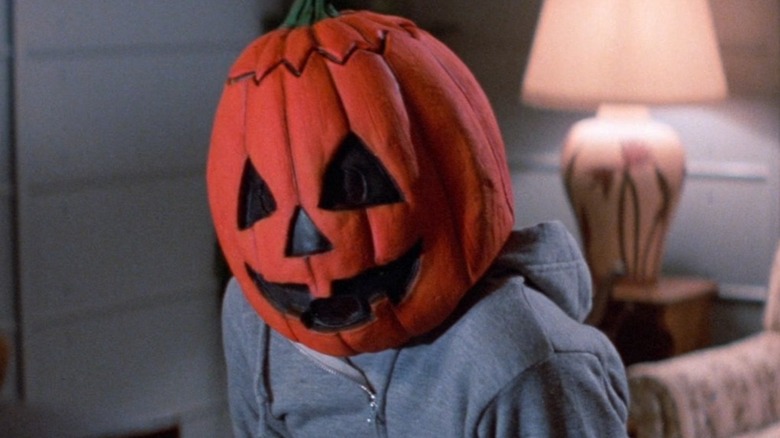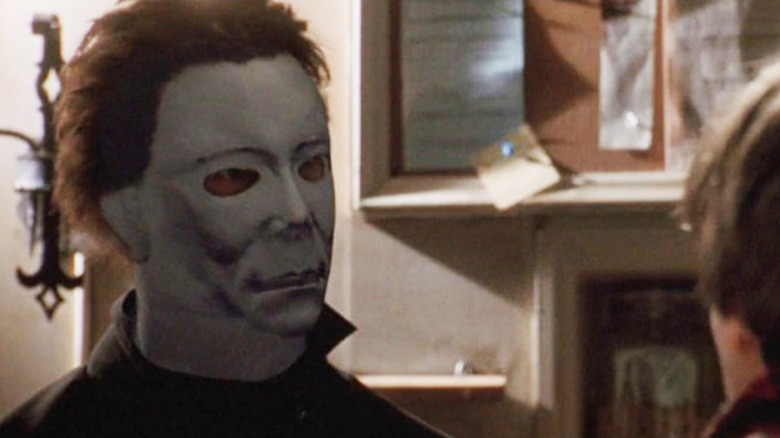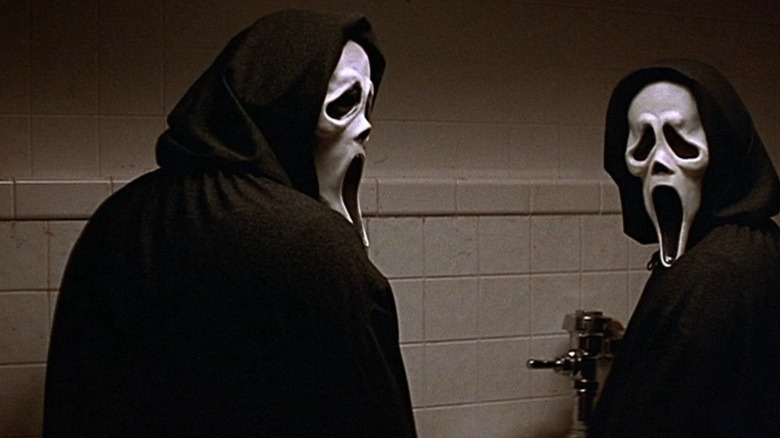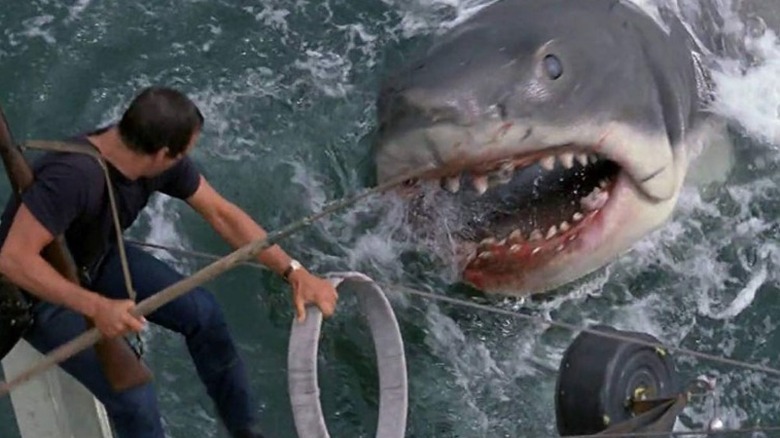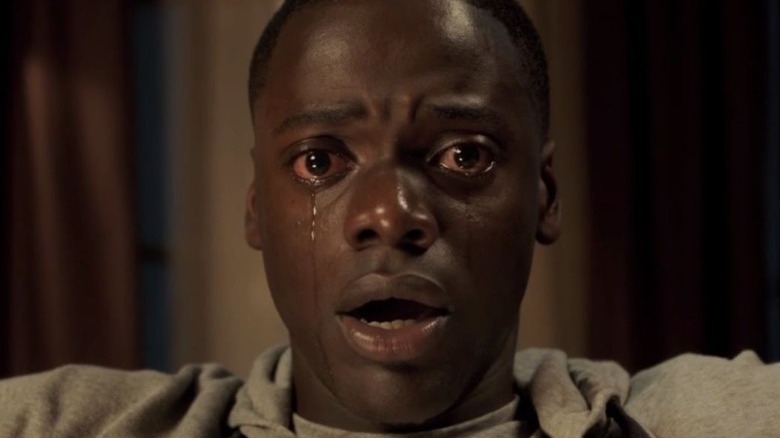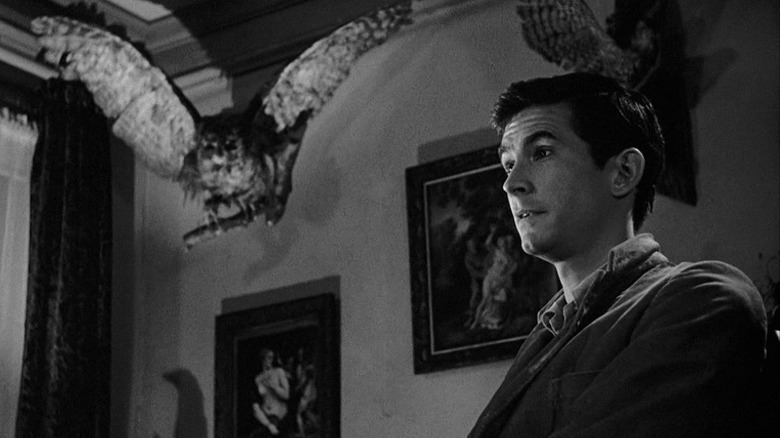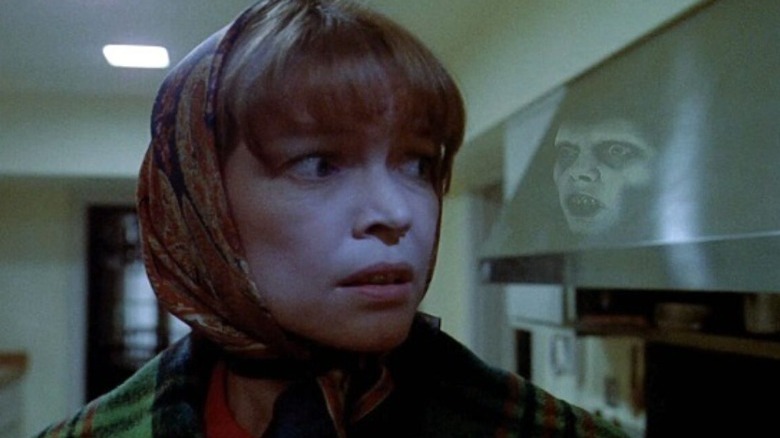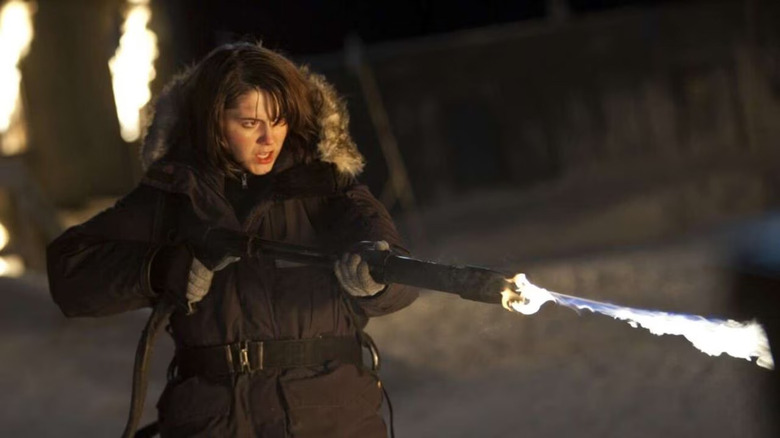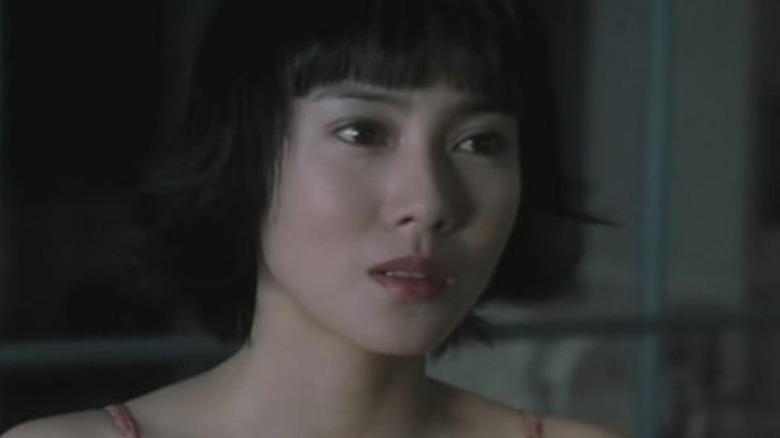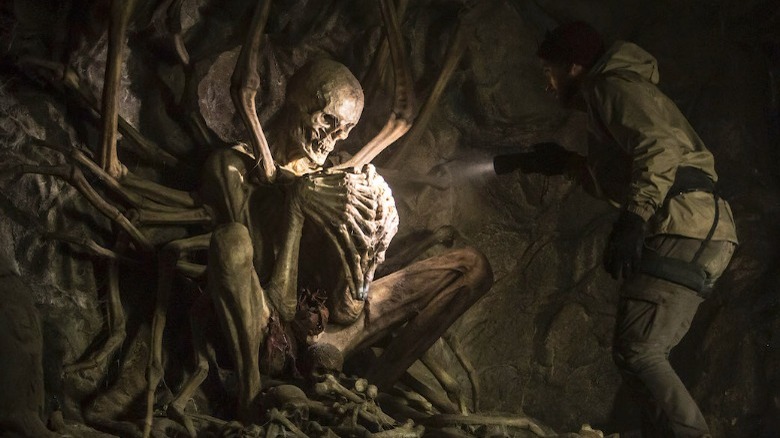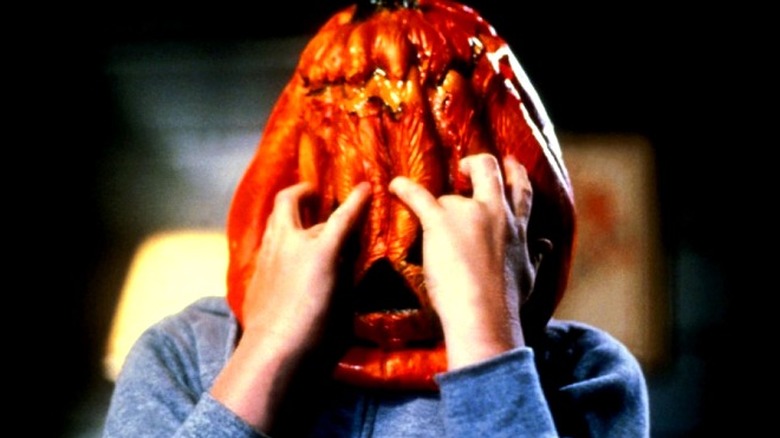Small Mistakes That Almost Ruined Horror Masterpieces
Movie mistakes come in a lot of different forms. Sometimes they're inconsequential gaffes, minor continuity errors, or shaky science. Sure, they're occasionally noticeable, but "The Shining" is still "The Shining," even if the infamous hedge maze is missing from the first overhead shot of the hotel. "Moonfall" is still "Moonfall," even if the moon would never quite fall like that. It's part of the filmmaking process itself. Some of it is practicality — like empty mugs movie characters toss around — and some is simply a matter of rushed schedules and truncated budgets.
Still, some mistakes are more consequential. Especially in horror films, these mistakes can make or break a movie, sucking the scares right out of the film reels. This list specifically focuses on small mistakes that almost ruined horror masterpieces. Luckily, most of these were addressed prerelease, leaving audiences with the classics they know and love today. While not every title here is an objective masterpiece, they are all part of masterful horror lineages; the names, faces, and scares are part and parcel with the horror genre itself.
Michael Myers is computer-generated
Michael Myers, like most slasher icons, is principally defined by his mask. With unclear mythos and no fewer than four distinct canonical timelines, the "Halloween" mask is the piece of iconography that holds the entire franchise together. In broader terms, the iterative masks are fiercely debated as fans all have a favorite. Yet, within the franchise the masks have been the equivalent of the mechanical shark in "Jaws," and it's a problem.
Beginning with "Halloween II," the original mask was used to better create the illusion the long-delayed sequel was a direct follow-up. However, on account of age, original co-writer Debra Hill's tobacco habit, and other bits of wear and tear, the mask needed considerable love and care to get into shape.
Additionally, "Halloween H20," on account of post-production interference, features Michael in an entirely computer-generated mask, arguably one of the worst in the series. Even "Halloween 4" is abounding with gaffes. In one key scene, Michael's mask incredulously features blond hair, a goof no one noticed until the movie was released theatrically. While silly in retrospect, the mask gaffes undermine their respective movies, jeopardizing the integrity of one of horror's most enduring icons.
Scream 2 script leaks changed the ending
The finale of "Scream 2" is the moment the franchise jumped the colloquial shark. Neve Campbell's Sidney Prescott is at Windsor College, and unfortunately, some knife-happy Ghostface killers have followed her, carving their way through co-eds en route to her. In the conclusion, Sidney finally unmasks the killers, revealing them to be film geek Mickey (Timothy Olyphant) and Mrs. Loomis (Laurie Metcalf), the mother of original killer Billy Loomis (Skeet Ulrich). Still, "Scream 2" is one of the best horror movies ever made, and certainly one of the best sequels, period.
Sure, the killer reveal is a little hammy — Mrs. Loomis recruited Mickey from some internet serial killer classifieds — but in the assured hands of Wes Craven, there was little that could ruin just how much fun it was. Well, other than script leaks. "Scream 2" had a notoriously rushed production, releasing less than a year after the first to capitalize on as much momentum as possible. Resultantly, everything moved at an accelerated clip, including script drafts.
One of these leaked online, spoiling Kevin Williamson's original ending. In addition to Mrs. Loomis and Mickey, Williamson had planned to include both boyfriend Derek (Jerry O'Connell) and roommate Hallie (Elise Neal) as the third and fourth killers, respectively. While fans might debate the efficacy of the idea, the actual reveal does reek of last-minute changes. It's effective enough ("Scream 2" rules, remember), but without the leaks, "Scream 2" might have had a little more time to iron out its big finale.
Jaws shark malfunctioned
It's the stuff of Hollywood legend. Steven Spielberg had planned to film much of "Jaws" with a mechanized shark. Well-known among prop aficionados, one of these sharks is presently available to view at the Academy Museum. As originally reported by Time Magazine in 1975, the mechanical sharks proved exceptionally difficult during production. They frequently malfunctioned, ballooned with water, and delayed shooting considerably alongside some bickering co-stars.
Resultantly, Spielberg had to refine the script, shifting focus during key scenes to keep the shark as obfuscated as possible, if not simply hidden entirely. Key scenes, such as the famous opening where swimmer Chrissie (Susan Backlinie) is dragged into the depths and devoured by a great white, are considerably more frightening as simulated. Without revealing the shark at all, Spielberg kept the tension high, accomplishing one of the most frightening horror movie opening scenes of all time.
Spielberg himself remarked, "The film went from a Japanese Saturday matinee horror flick to more of a Hitchcock, the less-you-see-the-more-you-get thriller." While it ostensibly spelled doom for the production, the malfunctioning shark, next to Spielberg himself, is the best thing that could have happened to "Jaws."
Get Out's horrific original ending
The theatrical ending to "Get Out" is pitch-perfect. Chris Washington (Daniel Kaluuya in an Oscar-nominated role), a Black Brooklyn photographer, has ostensibly escaped the clutches of his girlfriend Rose's (Allison Williams) twisted cult family. As he finally puts an end to Rose on a rural stretch of road, police sirens approach. In a movie that wickedly plays with contemporary race relations and systemic racism, audience members are expecting the worst. Luckily, the driver is Rod (Lil Rel Howery), a TSA officer and Chris' best friend. After almost two hours of Chris enduring tragedy and trauma, it's a welcome relief.
Yet, in Jordan Peele's original filmed ending, the police actually do arrive. Chris is arrested and prosecuted, a cruel way to end his compelling arc. Peele was luckily mindful enough to make the last-minute shift. In an interview with Vulture, producer Sean McKittrick spoke about the test screenings of the original ending, saying, "You could feel the air being sucked out of the room. The country was different." Had the original ending been left in, a horror masterpiece would have been marred by one of the genre's worst endings ever.
Psycho almost didn't feature its iconic score
Alfred Hitchcock's "Psycho" is a masterpiece in more ways than one. Among all its successes, though, it's the introduction and death of Janet Leigh's Marion Crane that resonates the strongest. Curiously, however, Hitchcock himself originally had a very different idea for her iconic shower death. Writing to composer Bernard Herrmann, Hitchcock said, "There should be no music at all through the next sequence (the first Motel sequence)." In other words, Hitchcock had originally planned to leave Marion's death scene silent.
Herrmann reportedly composed a score anyway on the chance the inimitable Hitchcock might change his mind. Luckily, he did, and a classic horror beat was born. The music is so iconic, that it's been featured in the likes of "Carrie" and others. Few pieces of score have endured as well as Hermann's "Psycho" theme. Had Hitchcock kept the scene silent as originally planned, its legacy would likely be very different than it is today.
Ellen Burstyn was seriously injured filming The Exorcist
Ellen Burstyn's Chris MacNeil, mother to possessed youngster Regan (Linda Blair), is a huge part of what makes "The Exorcist" such a devilishly famous slice of horror history. With grounded character work, Chris MacNeil is the horror mom to end all horror moms. Fiercely dedicated, but skeptical where it counts, Regan would still be spinning her head and spewing pea soup if not for Chris.
Burstyn, to her credit, earned an Oscar nomination for her role, though things could have gone very differently. A famously grueling shoot, director William Friedkin's cast had to endure more than most, though Burstyn likely had it the worst of anyone. In a climactic, mid-movie scene, Regan punches her mother and sends her flying across the room. Tethered to a pulley and wire around her midriff, Burstyn was pulled back by a crew member hidden behind a curtain to simulate the force of Regan's slap.
During a second take, captured on film, Burstyn is in real agony. The wire was pulled too hard, and an ambulance apparently had to be called for Burstyn. While Burstyn somewhat recovered (she calls the spot on her back where she hit the floor a "permanent companion" now), and will feature in David Gordon Green's sequel trilogy, the injury could have easily derailed the entire production.
The Thing almost ruined perfectly good monsters
Matthijs van Heijningen Jr.'s 2011 "The Thing," written by Oscar-nominated scribe Eric Heisserer, is considerably better than its critical reception might lead audiences to believe. At release, "The Thing" was often conceptualized as "serviceable." A decent prequel to John Carpenter's horror masterpiece (itself a remake of Christian Nyby's "The Thing from Another World"), Heijningen Jr.'s prequel has augmented its reception in retrospect. Its gaffes are reasonably interpreted as strengths, and in a rare move, "The Thing" actually makes Carpenter's original look that much better. It's difficult to extricate one from the other, and as a duology, it's one of the genre's most accomplished double-features.
Nevertheless, "The Thing" almost ruined any chance it had for contemporary reconsideration. Largely filmed with practical effects, "The Thing" was edited to death in post-production. In other words, all of the practical effects studioADI made for the film were discarded, replaced with unconvincing computer effects. Admittedly, the impact has been embellished some. Most of the time, "The Thing" looks fine. Still, as brethren to Carpenter's original, it's incredulous that the studio would jeopardize a core element of what made Carpenter's "The Thing" a modern classic.
Later, studioADI crowd-funded a movie of their own, "Harbinger Down," using practical effects and paying homage to films like "The Thing." In 2011, the shift from practical creature effects was almost enough to sink "The Thing" upon arrival. Years later, it's not quite enough to detract from how brilliantly it continues the original film's legacy.
Ringu's forgotten sequel
Fans of Hideo Nakata's "Ringu," sometimes simply titled "Ring," are likely aware of the franchise's enduring relevancy. Followed up by "Ringu 2," similarly helmed by Nakata, the curse of Sadako shows no signs of slowing down, most recently appearing in 2022's "Sadako DX" from Hisashi Kimura. Yet, outside of franchise diehards, Western audiences might not know that there was another direct sequel to Nakata's "Ringu" released right alongside the first.
In order to capitalize on the likely success of "Ringu," itself based on a best-selling novel from writer Koji Suzuki, a sequel titled "Spiral" was released into theaters with "Ringu" at the same time. "Ringu" was an unqualified success, which is no surprise given how the franchise endures to this day. "Spiral," meanwhile, was a critical and financial disaster, a movie that could have stopped the "Ring" film series dead in its tracks.
There are a lot of reasons it likely failed, whether that be an oversaturation of the market or a ridiculous ending that retroactively hurts the first. No matter the reason, Nakata had to direct another sequel to compensate, all but consigning "Spiral" to the realm of forgotten sequels. At least "The Rage: Carrie 2" is good company.
Cult classic The Empty Man's disastrous theatrical release
"The Empty Man" didn't make much of an impact until it arrived on home video in January 2021. Serendipitously, the right people saw "The Empty Man" at the right time, and David Prior's movie, adapted from Cullen Bunn and Vanesa R. Del Rey's comic book of the same name, has become something akin to a modern cult classic. Released in October 2020, "The Empty Man" was long delayed until it hit theaters, part of a mandated release wrapped in Disney's acquisition of 20th Century Fox.
Disney, as Disney is wont to do with Fox properties, dumped "The Empty Man" in theaters at a time where, on account of the Covid-19 pandemic, theaters weren't even open. Those that were amounted to ghost towns. Several months after Covid hit domestic shores, no one was risking it to see a cerebral horror IP.
Luckily, its streaming success has been enough to compensate for a release that could have reasonably ruined the movie's chance of success forever. Wildly successful on streaming, "The Empty Man" is hailed as one of the century's boldest, most original horror offerings. It's not perfect, but few horror movies in the last decade have taken as many big swings as "The Empty Man." Sure, it looks and sounds like a conventional haunter, but Prior takes the material to some weird places, and it's all the better for it.
Michael Myers isn't in Halloween III: Season of the Witch
Tommy Lee Wallace's "Halloween III: Season of the Witch" is a classic, no doubt about it. The iconographic Silver Shamrock masks, part of the horror film's core conflict surrounding Halloween masks being used to take over the world, have even featured in both of David Gordon Green's contemporary "Halloween" sequels. It's big, grinning Halloween cheese, with Tom Atkins, hordes of icky insects, and some genuinely well-designed masks at its core. Still, at the time of release — especially in an era that predated accessible home video and streaming — "Season of the Witch" was a disaster.
Michael Myers would return six years later in "Halloween 4: The Return of Michael Myers" to compensate for the failure of the "Season of the Witch." John Carpenter and Debra Hill had, at the time, envisioned the "Halloween" franchise as an anthology following the conclusion of "Halloween II." Resultantly, "Season of the Witch" bore the "Halloween" moniker, just without everyone's favorite slasher Michael Myers. Audiences were furious, and it took decades for franchise fans to reclaim Wallace's sequel.
At the time, however, "Halloween 4" was the knife in the third film's heart. It was the studio's way of urging audiences to forget what happened six years before. In truth, "Halloween III" might have had better contemporaneous success had it simply dropped the "Halloween" moniker and released it as its own thing.
